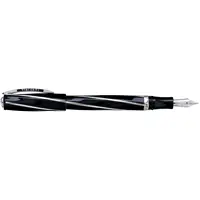Visconti Divina Black Collection
Visconti 5 stars, based on 1 reviewfrom € 860.66
Visconti Divina Black Oversize fountain pen - stilografica

Available colours
Available types
VISCONTI DIVINA BLACK Collection
Divina is a collection of very innovative writing instruments that carries in its DNA the Italian Renaissance, Leonardo da Vinci and the golden number (1,618), which is said to transmit the key of knowledge.
The golden ratio applied for the first time to a writing instrument has generated a revolutionary design changing the aesthetic canons of fountain pens.
Some of the distinctive elements are the pentagram and the proportion between cap and section, but the really captivating feature is the golden spiral that harmoniously envelops the pen.
These elements melt together in alchemy of forms and proportions to make a pen that can be defined as the fifth essence of elegance: so modern to seam timeless, so ancient to seam supernatural.
In one word: Divina.
ALL MAGIC IN A NUMBER
The Divine Proportion is based on the golden number, which according to someone contains the key of knowledge.
The number is 1,618 and it corresponds to what is considered a “particularly aesthetic ratio”. In fact it defines the “ideal relation”, an arithmetic measure which is enjoyable for the eye, called also “golden mean proportion” or “golden section”.Without getting into great depth we can say that this number, also called phi, is as well used to trace different circles divided through ten – called decagons – or through five – i.e. pentagons, called pentagrams or pentacles too.The empiric discovering of the golden ration “comes from the most remote ancient times, from the prehistoric era”. We presume that our ancestors learned very soon how to trace and divide circles; they of course privileged the division of circles through five, because of the five fingers of the human hand.
These are in fact “obvious” numbers indeed they lead to the natural calculation of some special proportions. However only the Greeks, first of all Euclid, originally theorised these calculations. Before him Pythagoras - or at least his disciples - tried to disclose their mystery.Inside their sect, which was protected by the most absolute secret, the golden number was associated to the sacred, particularly to the five-pointed star - a symbol of life, beauty and love.
The pentacle is commonly thought to be the symbol through which the Pythagoreans recognised each others, but it came into our tradition throughout the centuries as a talisman of good health: we find it on some ancient coins and on several gothic cathedrals and churches. Also Plato recognised that the golden number had a privileged role in the explanation of the universe.
During the XII century, Fibonacci, also Called Leonardo da Pisa, mathematician, merchant and great traveller got in touch with this scientific discipline in the Middle East, developing the famous “Fibonacci sequences”. For the architects and painters of the Middle Ages the pentagon became the symbol of the “Quintessence”, literally said “the fifth element”, i.e. absolute perfection, ideal beauty. The pentacles and circles traced with the compass were kept absolutely secret among the corporations.In 1509 Leonardo Da Vinci illustrates De divina proportione, the work of a Franciscan mathematician, Luca Pacioli. This book with pictures by Da Vinci had a great success, as it was the written version of an ancient oral tradition. It was revealing a mystery.Today we know that the divine proportion is present in architecture (Le Corbusier frequently used it), in painting, in music, in the structure of some poems, but also in nature, in many plants and animals (many flowers have five petals, some leaves are placed on stems according to the phi ratio, which is present also in the starfish and the sea urchin). The divine proportion seems also to rule the human body: the navel, for example, divides the body according to the golden number.
DESIGN ELEMENTS
The inspiring concepts are: the Golden Number, the Pentagram, and the Nautilus.· The Golden Number: the ratio between the length of cap and pen in both open and close conditions reflecting the divine proportion.· The Pentagram: it is part of the form of the pen itself, of course adapted to the ergonomic needs of a writing instrument. · The Nautilus or “Golden Spiral”: according to the Fibonacci Series, the Golden Spiral envelops the pen without braking up.
TECHNICAL CHARACTERISTICS:
Material: Black Lucite
Finishing: Silver 925
Filling System: Pull & TurnPen
Oversize Fountain pen Nib: 18kt Rhodium-plated gold
Regular (medium size) Fountain pen Nib: 18kt Rhodium-plated gold
